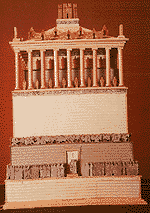One of Seven Wonders of the Ancient World
|
 The mausoleum was the tomb of Mausolos, from where the name came, and it was the most enduring achievement of his wife/sister Artemisia THE Younger, who, after Mausolos death in 352 BC, had it built in his honor. Mausolos tomb became one of the most famous architectural showpieces of antiquity; it was named one of the seven wonders of the world by the travel writers of the Hellenistic era. It consisted of a solid rectangular base topped by 36 Ionic columns. These were surmounted by a pyramid and crowned with a massive statue of Mausolos and Artemisia riding a chariot, reaching a total height of 40 mt.. the base was adorned with a frieze executed by four of the leading sculptors of ancient Greece, one per side; classical writers were most impressed by these sculptures.The Mausoleum dominated the skyline of the city at least until the 12th century; by the early 15th century it lay in ruins, most likely due to the earthquakes frequent in the area. The Knights of St. John put the remaining stones to use as building material for the Bodrum castle. One can still observe large slabs of greenish granite and the classical architectural fragments embedded in the castle walls. The mausoleum was the tomb of Mausolos, from where the name came, and it was the most enduring achievement of his wife/sister Artemisia THE Younger, who, after Mausolos death in 352 BC, had it built in his honor. Mausolos tomb became one of the most famous architectural showpieces of antiquity; it was named one of the seven wonders of the world by the travel writers of the Hellenistic era. It consisted of a solid rectangular base topped by 36 Ionic columns. These were surmounted by a pyramid and crowned with a massive statue of Mausolos and Artemisia riding a chariot, reaching a total height of 40 mt.. the base was adorned with a frieze executed by four of the leading sculptors of ancient Greece, one per side; classical writers were most impressed by these sculptures.The Mausoleum dominated the skyline of the city at least until the 12th century; by the early 15th century it lay in ruins, most likely due to the earthquakes frequent in the area. The Knights of St. John put the remaining stones to use as building material for the Bodrum castle. One can still observe large slabs of greenish granite and the classical architectural fragments embedded in the castle walls.The site of the Mausoleum was discovered in 1857 by the English orientalist Sir Charles Newton who was conducting an expedition on behalf of the British Museum (his other finds on this campaign included Didyma and Cnidus). The building was gone, but Newton found pieces of the Mausoleum frieze in the basement of the site as well as in villagers' backyards and in the walls of their houses. With the help of Sir Stratford Canning, the British ambassador at Istanbul, these were collected and transferred to the British Museum. For many years afterward the Mausoleum site remained a vegetable patch and cow-shed on private property. For at least the last 20 years a Danish team of archaeologists and conservators, led by Prof. Kristian Jeppesen of the Aarhus University in Denmark, has been excavating and preserving the little remains of the site, consisting on the funerary underground chamber and architectural remains, many of them were found in the vicinity and the castle. The Mausoleum Museum was opened in 1988 thanks to the join auspices of the Turkish and Danish governments, now under the management of the Bodrum Museum of Underwater Archaeology. The exhibit includes a piece of the Mausoleum frieze that was found embedded in the castle walls and so escaped the depredations of Newton. Visit: www.bergintours.com |
Who has never heard of shish kebab? In Turkish, shish kebab, literally means “gobbets of meat roasted on a spit or skewers.” Probably the most famous preparation for grilled lamb, there seems to be countless recipes. It is said that shish kebab was born over the open field fires of the soldiers of the Turkic tribes that first invaded Anatolia, who used their swords to grill meat, as they pushed west from their homelands in Central Asia. Given the obvious simplicity of spit-roasting meat over a fire, I suspect its genesis is earlier. There is iconographical evidence of Byzantine Greeks cooking shish kebabs. But surely the descriptions of skewering strips of meat for broiling in Homer’s Odyssey must count for an early shish kebab. In the Arab world, the same preparation is called shish kabab or lahm mishwy (grilled meat). The true shish kebabs are pieces of marinated lamb affixed to flat or four-sided bladed metal skewer...

Yorumlar
Yorum Gönder